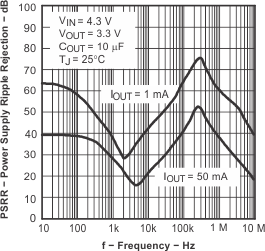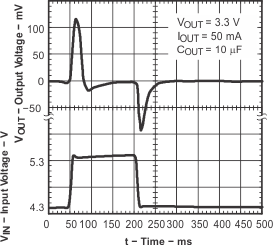SBVS340 June 2017 TPS715A-NM
PRODUCTION DATA.
- 1 Features
- 2 Applications
- 3 Description
- 4 Pin Configuration and Functions
- 5 Specifications
- 6 Detailed Description
- 7 Application and Implementation
- 8 Power Supply Recommendations
- 9 Layout
- 10Device and Documentation Support
- 11Mechanical, Packaging, and Orderable Information
5 Specifications
5.1 Absolute Maximum Ratings
over operating temperature range (unless otherwise noted)(1)| MIN | MAX | UNIT | |
|---|---|---|---|
| Input supply voltage, VIN | –0.3 | 24 | V |
| Peak output current | Internally limited | ||
| Continuous total power dissipation | See Thermal Information | ||
| Junction temperature, TJ | –40 | 125 | °C |
| Storage temperature, Tstg | –65 | 150 | °C |
(1) Stresses beyond those listed under absolute maximum ratings may cause permanent damage to the device. These are stress ratings only, and functional operation of the device at these or any other conditions beyond those indicated under recommended operating conditions is not implied. Exposure to absolute-maximum-rated conditions for extended periods may affect device reliability.
5.2 ESD Ratings
| VALUE | UNIT | |||
|---|---|---|---|---|
| V(ESD) | Electrostatic discharge | Human body model (HBM), per ANSI/ESDA/JEDEC JS-001(1) | ±2000 | V |
| Charged device model (CDM), per JEDEC specification JESD22-C101(2) | ±500 | |||
(1) JEDEC document JEP155 states that 500-V HBM allows safe manufacturing with a standard ESD control process.
(2) JEDEC document JEP157 states that 250-V CDM allows safe manufacturing with a standard ESD control process.
5.3 Recommended Operating Conditions
over operating free-air temperature range (unless otherwise noted)| MIN | NOM | MAX | UNIT | ||
|---|---|---|---|---|---|
| VIN | Input supply voltage | 2.5 | 24 | V | |
| IOUT | Output current | 0 | 80 | mA | |
| CIN | Input capacitor | 0 | 0.047 | µF | |
| COUT | Output capacitor | 0.47 | 1 | µF | |
5.4 Thermal Information
| THERMAL METRIC(1) | TPS715A-NM | UNIT | ||
|---|---|---|---|---|
| DRV (SON) | DRB (SON) | |||
| 6 PINS | 8 PINS | |||
| RθJA | Junction-to-ambient thermal resistance | 79.5 | 69 | °C/W |
| RθJC(top) | Junction-to-case (top) thermal resistance | 110.5 | 76.8 | °C/W |
| RθJB | Junction-to-board thermal resistance | 48.9 | 44.6 | °C/W |
| ψJT | Junction-to-top characterization parameter | 5.2 | 8.1 | °C/W |
| ψJB | Junction-to-board characterization parameter | 49.3 | 44.8 | °C/W |
| RθJC(bot) | Junction-to-case (bottom) thermal resistance | 18.3 | 27.5 | °C/W |
(1) For more information about traditional and new thermal metrics, see the Semiconductor and IC Package Thermal Metrics application report, SPRA953.
5.5 Electrical Characteristics
Over operating junction temperature range (TJ = –40°C to 125°C), VIN = VOUT(NOM) + 1 V, IOUT = 1 mA, COUT = 1 μF, unless otherwise noted. The TPS715A01 device is tested with VOUT = 2.8 V. Typical values are at TJ = 25°C.| PARAMETER | TEST CONDITIONS | MIN | TYP | MAX | UNIT | |
|---|---|---|---|---|---|---|
| Input voltage(1) | VIN | IOUT = 10 mA | 2.5 | 24 | V | |
| IOUT = 80 mA | 3 | 24 | ||||
| Voltage range (TPS715A01) | VOUT | 1.2 | 15 | V | ||
| Output voltage accuracy(1) | TPS715A01 | VOUT + 1 V ≤ VIN ≤ 24 V, 1.2 V ≤ VOUT ≤ 15V, 0 ≤ IOUT ≤ 80 mA |
0.96 × VOUT(nom) | VOUT(nom) | 1.04 × VOUT(nom) | V |
| TPS715A33 | 4.3 V < VIN < 24 V, 0 ≤ IOUT ≤ 80 mA | 3.135 | 3.3 | 3.465 | ||
| Output voltage line regulation(1) |
ΔVOUT/ΔVIN | VOUT + 1 V < VIN ≤ 24 V | 20 | 60 | mV | |
| Load regulation | ΔVOUT/ΔIOUT | IOUT = 100 μA to 80 mA | 35 | mV | ||
| Dropout voltage VIN = VOUT(NOM) – 0.1 V |
VDO | IOUT = 80 mA | 670 | 1120 | mV | |
| Output current limit | ICL | VOUT = 0 V | 160 | 1100 | mA | |
| Ground pin current | IGND | TJ = –40°C to 85°C, 0 mA ≤ IOUT ≤ 80 mA | 3.2 | 4.2 | μA | |
| 0 mA ≤ IOUT ≤ 80 mA | 3.2 | 4.8 | ||||
| VIN = 24 V, 0 mA ≤ IOUT ≤ 80 mA | 5.8 | |||||
| Power-supply ripple rejection | PSRR | f = 100 kHz, COUT = 10 μF | 60 | dB | ||
| Output noise voltage | VIN | BW = 200 Hz to 100 kHz, COUT = 10 μF, IOUT = 50 mA |
575 | μVrms | ||
(1) Minimum VIN = VOUT + VDO, or the value shown for input voltage, whichever is greater.
5.6 Typical Characteristics
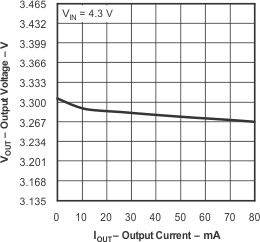



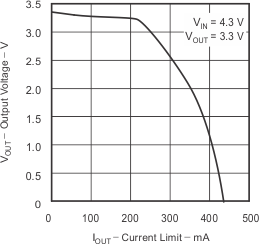
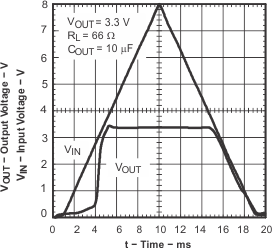

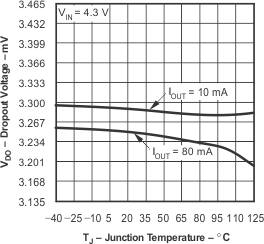
Junction Temperature
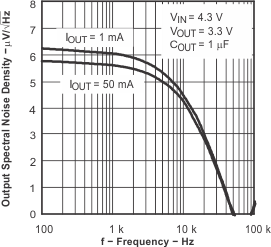

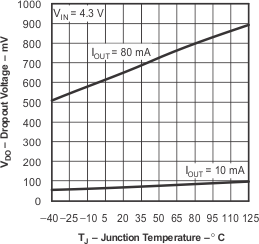
Junction Temperature
